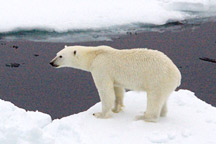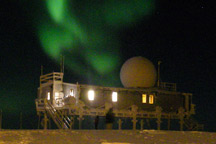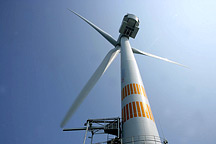Recent Features
 Sea Ice
April 20, 2009
Sea Ice
April 20, 2009
Polar sea ice grows and shrinks dramatically each year, driven by seasonal cycles. Habitat for wildlife and harbinger of changing climate, sea ice offers scientists important clues about the state of our planet.
 Winter Camp: A Blog from the Greenland Summit
February 20, 2009
Winter Camp: A Blog from the Greenland Summit
February 20, 2009
Lora Koenig, a remote-sensing glaciologist at NASA’s Goddard Space Flight Center, spent three dark, frigid months supporting research at the National Science Foundation’s Greenland Summit Camp. Near the end of her stay, Koenig emailed the Earth Observatory answers to a few questions about how she wound up in Greenland and what is was like to spend the winter there.
 An Ocean Breeze: Mapping Brazil’s Offshore Wind Power Potential
February 3, 2009
An Ocean Breeze: Mapping Brazil’s Offshore Wind Power Potential
February 3, 2009
Searching for alternative sources of energy for his country, one student turned to a NASA satellite to assess the feasibility of offshore wind power in Southeast Brazil.
- read more Features
From the Archives
- Showdown in the Rio Grande
July 22, 2002
ASTER satellite images have been used to find and track infestations of water hyacinths in the Rio Grande in Texas, as well as to monitor the success of plant eradication techniques.
- When the Dust Settles (DAAC Study)
May 18, 2001
African dust can both benefit and harm Caribbean coral reefs. Scientists have new evidence of a similar connection between dust and phytoplankton (related press release).
- Why EOS Matters
December 17, 1999
Nearly a decade ago, ecologist Steve Running described how NASA’s Earth Observing System missions were going to help us answer this crucial question: Is the current human occupancy and activity of planet Earth sustainable?
Most Popular
- Cities at Night: The View from Space
April 22, 2008
Astronauts onboard the International Space Station capture nighttime photographs of city lights, spectacular evidence of humanity's existence, our distribution, and our ability to change our environment.
- Global Warming
May 21, 2007
Global warming is happening now, and scientists are very confident that greenhouse gases are responsible. This article explains what global warming is, how scientists know it's happening, and how they predict future climate.
- Tropical Deforestation
March 30, 2007
Tropical forests are home to half the Earth's species, and their trees are an immense standing reservoir of carbon. Deforestation will have increasingly serious consequences for biodiversity, humans, and climate.
- Hurricanes: The Greatest Storms on Earth
November 1, 2006
Few things in nature can compare to the destructive force of a hurricane. Called the greatest storm on Earth, a hurricane is capable of annihilating coastal areas with sustained winds of 155 mph or higher and intense areas of rainfall and a storm surge. In fact, during its life cycle a hurricane can expend as much energy as 10,000 nuclear bombs!
- How on Earth was this Image Made?
March 25, 2003
Remotely sensed Earth observations can include everything from sonar measurements used to map the topography of the ocean floor to satellite-based observations of city lights. Combining observations collected by a variety of instruments at different times and places allow scientists to create an otherwise impossible view of the Earth, showing underwater mountain ranges, cloud-free skies, and city lights that are brighter than daylight. Such visualizations are invaluable for interpreting complex data and communicating scientific concepts.